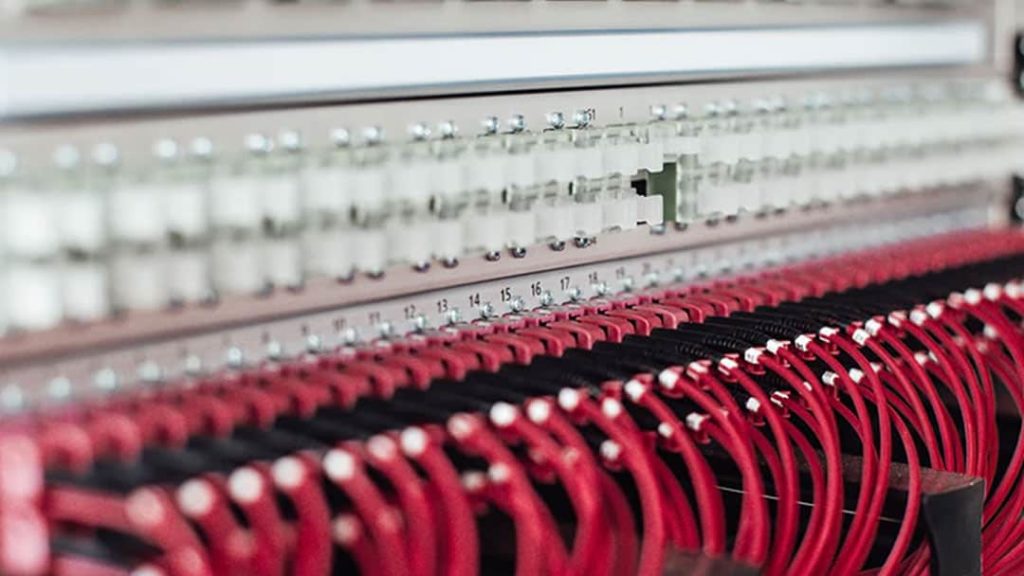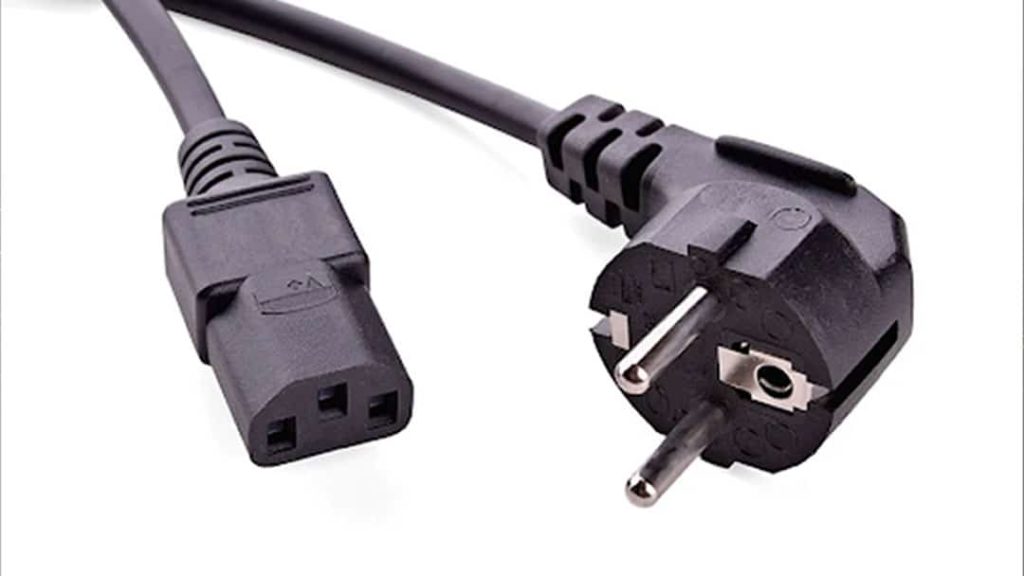In the realm of information technology, data centers serve as the foundational infrastructure for businesses worldwide, and their design, construction, and operation are crucial for ensuring robust performance, security, and reliability. Data center standards play a central role in outlining the best practices and methodologies for achieving these objectives. These standards, created by international bodies and industry groups, provide comprehensive guidelines covering everything from the architectural planning of the facility to the implementation of security protocols, ensuring that data centers operate at optimum efficiency and minimal risk.
The assortment of data center standards includes widely recognized benchmarks such as ANSI/TIA-942, ISO/IEC 22237-series, and ANSI/BICSI 002-2019, each offering a detailed framework for different aspects of data center requirements. These standards address a broad range of needs including general design, security measures, energy efficiency, environmental considerations, and operational procedures to establish a resilient and sustainable IT infrastructure. By adhering to such frameworks, organizations can guarantee that their data centers are capable of supporting current and future technological demands while mitigating downtime and potential threats.
Key Takeaways
- Data center standards provide essential guidelines for design, security, and operational efficiency.
- Adherence to these standards ensures data centers meet current and future technological needs.
- International and industry-specific frameworks form the basis for developing resilient IT infrastructures.
Data Center Design Fundamentals
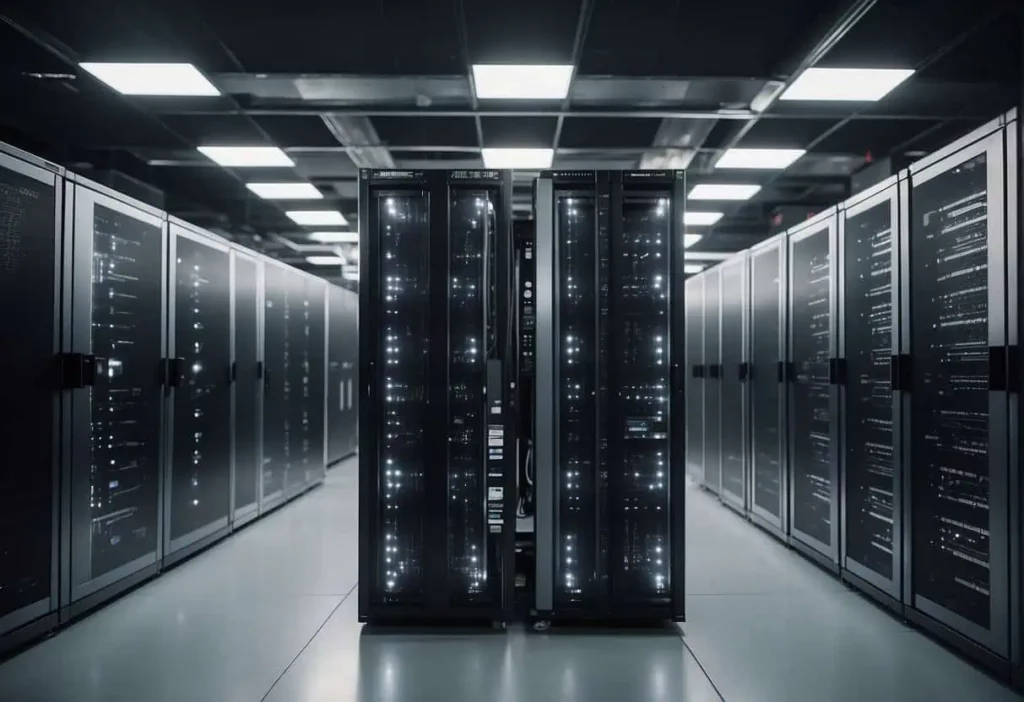
Data center design is a multi-faceted discipline that requires meticulous planning to meet the rigorous standards of modern IT infrastructure. As enterprises depend heavily on the reliability and efficiency of their data centers, every element from architectural design to security protocols is critical.
Architectural Design
The architectural design of a data center should fundamentally support robust IT infrastructure. Key elements include:
- Racks: Standardized for equipment, ensuring proper airflow.
- Cabling: Organized to facilitate both power distribution and data transmission.
- Lighting: Adequate for operations, maintenance, and energy efficiency.
Space Planning
Efficient space planning is crucial in a data center to ensure scalability and operational efficiency. Factors to consider include:
- Floor Layout:
- Allocation of space for IT equipment and staff.
- Designated areas for future expansion.
- Cooling Zones:
- Hot and cold aisle layouts to optimize cooling.
- Adequate spacing between racks to prevent hotspots.
Security Considerations
Security in data center design encompasses both cybersecurity measures and physical security protocols. It involves:
- Physical Security:
- Restricted access to sensitive areas.
- Surveillance systems to monitor and protect the facility.
- Operational Protocols:
- Procedures for access control, such as biometric systems.
- Regular auditing of physical security measures.
Core Infrastructure
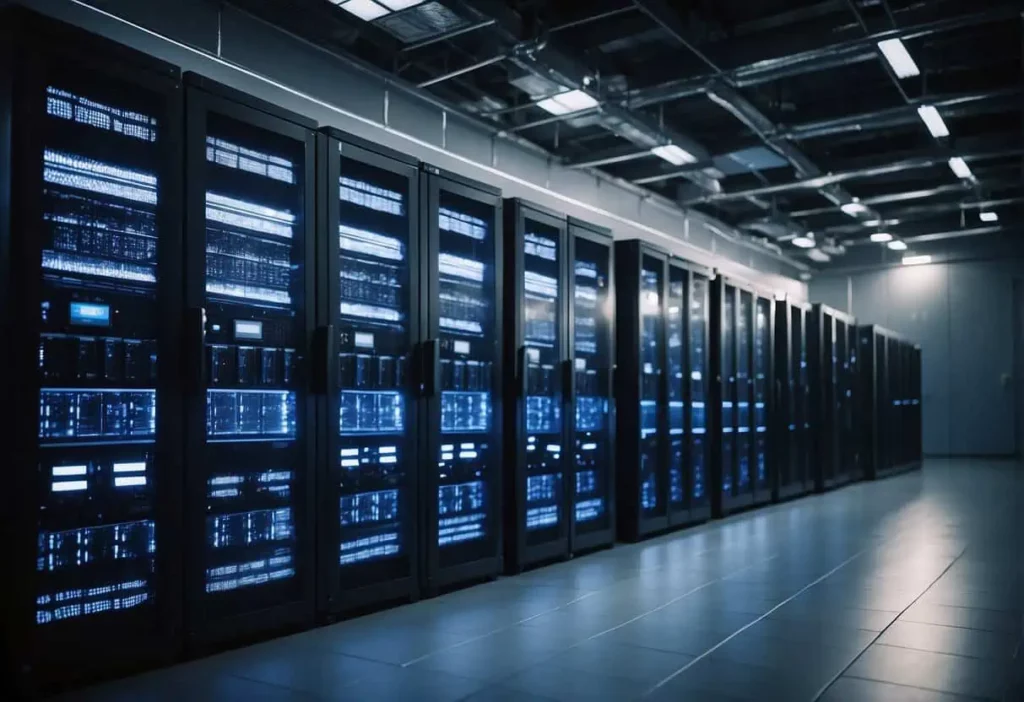
The core infrastructure in data centers encompasses robust electrical and mechanical systems, along with efficient cooling solutions. These systems are integral to the uptime and sustainability of data centers, ensuring that power is effectively distributed and managed with redundancy measures such as backup power in place.
Electrical Systems
Data centers rely on a continuous, uninterruptible power supply (UPS) to maintain operations. Electrical systems must have redundancy, typically N+1 or 2N, to avoid any single point of failure that could lead to downtime. The implementation of energy-efficient solutions, such as Energy Star-rated UPS systems, contributes to the overall sustainability of the infrastructure.
- Redundancy Configuration:
- N+1: Provides one independent backup component or path.
- 2N: Offers a parallel redundant configuration for additional security.
- Energy Efficiency Features:
- Modular UPS: Scales with data center needs and optimizes power usage.
- Eco Mode: Reduces energy consumption during periods of low load.
Mechanical Systems
Mechanical systems in data centers include all components that support the mechanical functions such as fire protection and ventilation. They form a pivotal part of the physical infrastructure designed to safeguard against operational failures. These systems must comply with national and local codes to meet regulatory standards that ensure the safety of the facility.
- Key Mechanical Components:
- Fire suppression systems: Utilize clean agents for effective, equipment-safe fire protection.
- Ventilation systems: Provide adequate airflow necessary to support both cooling and air quality.
Cooling Solutions
Efficient cooling solutions are critical for maintaining the proper operating temperatures of data center equipment. Advances in technology enable the deployment of cooling systems that adapt to the load, reducing waste and increasing energy efficiency. The design of these systems often targets the elimination of hot spots and the optimal distribution of cooled air.
- Types of Cooling Systems:
- In-row cooling: Closely couples with server racks for targeted temperature control.
- Cold/hot aisle containment: Arranges racks in alternating rows with cold air intakes all facing one aisle and hot air exhausts facing another.
- Sustainability Practices in Cooling:
- Utilization of outside air (free cooling) when conditions permit.
- Implementation of variable frequency drives (VFD) in cooling units to adjust motor speeds based on demand.
Operational Excellence
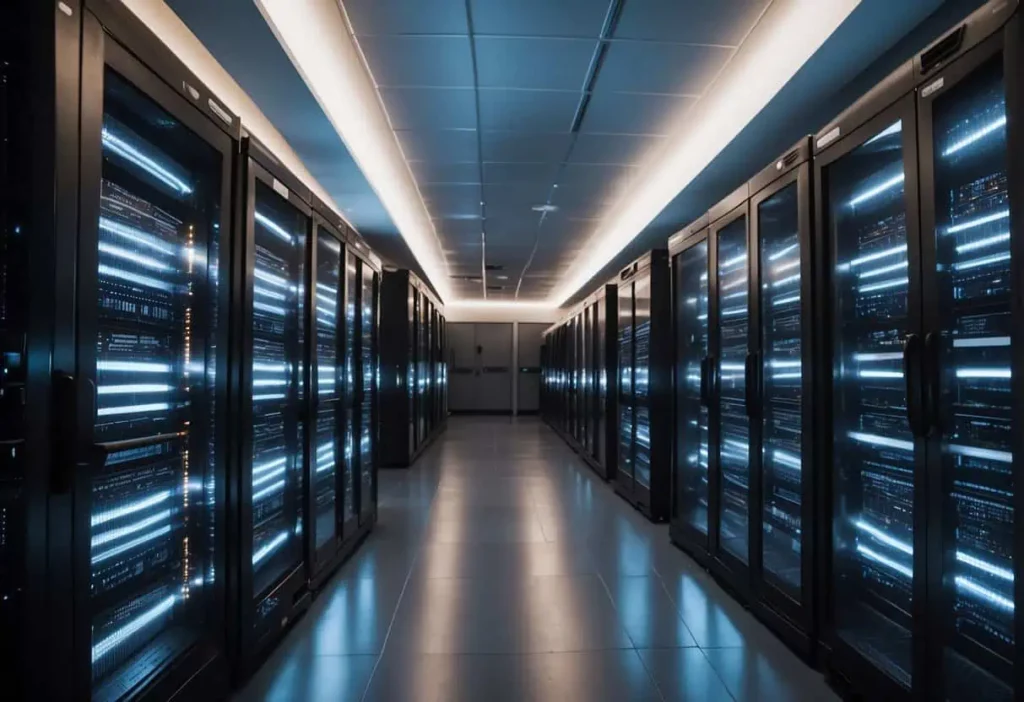
In the context of data center operations, achieving operational excellence is pivotal. It involves adhering to stringent standards, establishing rigorous maintenance protocols, and implementing comprehensive monitoring and management systems to ensure quality, consistency, and reliability.
Maintenance Procedures
Regular maintenance is essential for the longevity and reliability of data center operations. Scheduled maintenance ensures that all equipment is operating efficiently and prevents potential failures. A robust set of procedures typically aligns with standards such as ISO 9000 and ISO 14000, focusing on quality management and environmental management, respectively.
- System Checks: Routine inspections and system upgrades.
- Documentation: Detailed records of all maintenance activities.
Monitoring and Management
Effective monitoring and management are crucial for maintaining operational excellence. Data Center Infrastructure Management (DCIM) tools play a vital role in overseeing facility operations. They enable real-time tracking of performance metrics ensuring that the data center meets Uptime Institute’s Tier Standard for uptime and redundancy.
- Real-time Analytics: Dashboards displaying system health and alerts.
- Incident Response: Quick identification and resolution of issues.
Standards and Compliance
Standards and compliance frameworks provide a structure that guides data center operations toward excellence. Adherence to regulatory standards like ISO 27001, SOC 2, ISAE 3402, and SSAE 16 is critical for ensuring data security and availability. Data centers must also comply with specific regulations like FFIEC, HIPAA, SOX, and GLBA, depending on their industry focus.
- Certifications: Proof of compliance with industry standards.
- Audits: Regular assessments to validate adherence to operational standards.
Operational excellence in data center management is not just a goal, but a continuous journey that demands diligence, adherence to standards, and a proactive approach to maintenance and monitoring.
Technology and Systems
In data centers, technology and systems play a pivotal role in managing and facilitating the smooth operation of networking, servers, storage, and telecommunications. These components are foundational to the data processing, storage, and connectivity that empower today’s digital applications.
Networking Components
The network is the backbone of a data center, providing essential connectivity between servers, storage devices, and telecommunication systems. Networking components include switches, routers, and firewalls, which are configured to ensure high availability, scalability, and security for data traffic.
- Switches: Deployed to create network segments and manage traffic.
- Routers: Connect diverse networks to route data packets efficiently.
- Firewalls: Protect data center networks from unauthorized access.
Servers and Storage
Servers are the workhorses of a data center, running the applications and processes that handle the complex computations and data management required by businesses. Storage systems, on the other hand, are optimized to store, retrieve, and back up vast quantities of data.
- Server Types: Rack, blade, and tower servers cater to various needs.
- Storage Solutions: Includes SAN, NAS, and object storage architectures.
Servers and storage systems must be robust and adaptable to keep up with the growing data demands and applications they support.
Telecommunications
Telecommunications infrastructure in data centers is crucial for maintaining external and internal communications, facilitating data transmission across various networks and to end-users.
- Telecom Standards: Ensure compatibility and reliability for network operators.
- Components: Include cabling, antennas, and signal amplifiers.
Data centers must adhere to stringent telecommunications standards, such as those developed by ANSI/TIA-942 and ISO/IEC, to maintain high-performance levels and enable future growth.
Sustainable Practices and Energy Management
In the realm of data centers, the adoption of sustainable practices and rigorous energy management is crucial. These centers are integral to modern technology infrastructure, thus their energy consumption and efficiency are of global concern.
Renewable Energy Integration
Data centers are increasingly integrating renewable energy sources such as solar, wind, and hydro power to reduce their carbon footprint. Renewable energy not only aligns with sustainability goals but also mitigates dependency on non-renewable sources. For example, the Energy Act of 2020 highlights the importance of energy-efficient technology combined with sustainable energy sources to improve overall efficiency.
- Solar panels on-site or via power purchase agreements (PPAs)
- Wind turbines installed on-premises or through off-site contracts
- Use of low-impact hydropower solutions where geographically viable
Energy-Efficient Systems
Energy-efficient systems within data centers include the deployment of advanced cooling mechanisms and innovative IT equipment that require less energy to perform optimally. Proper management involves designing energy-efficient systems that not only reduce operational costs but also contribute to a facility’s overall energy efficiency.
- Advanced Cooling Solutions:
- Liquid cooling systems
- Free air cooling using external temperatures
- IT Equipment:
- High-efficiency power supplies
- Energy Star certified hardware
Deploying these technologies aligns with the Federal Energy Management Program’s best practices for creating energy-efficient data center designs, which ultimately support sustainability and reduce environmental impact.
Construction and Implementation
When constructing a data center, adherence to recognized standards, such as the ANSI/BICSI 002-2019, is paramount to achieve optimal design and functionality. Careful planning during the implementation phase ensures that services meet expectations for availability and operational sustainability.
Building Construction
Standards Compliance: Building construction must follow guidelines such as the EN 50600 series to ensure the reliability and security of the data center. The structure should facilitate services while aiming for high availability levels, often dictated by certifications such as the Uptime Institute’s operational sustainability benchmarks.
- Materials and Design:
- Use materials that offer protection against environmental hazards.
- Incorporate design elements that support efficient cooling and power distribution.
- Location and Space Planning:
- Select sites with minimal exposure to natural disasters.
- Plan for scalable growth to accommodate future technology changes or service expansions.
Implementation Strategies
Best Practices: Following best practices from standards like ANSI/BICSI 002-2019, the implementation phase should include thorough risk assessments and integration of modular elements for flexibility.
- Service Continuity:
- Implement redundancy systems to maintain uninterrupted services.
- Regularly test backup systems to ensure they meet uptime requirements.
- Operational Considerations:
- Document procedures and protocols for maintaining consistent operational standards.
- Strategically schedule maintenance to minimize impact on services.
International Standards and Frameworks
In the realm of data centers, adherence to international standards and frameworks is essential for ensuring quality, reliability, and redundancy. These standards dictate the architecture and operational protocols of facilities, from power systems to cooling methods.
Global Standardization
ANSI/BICSI 002-2014 is a critical standard for data center design and construction, offering a comprehensive guide that includes best practices for power demands, cooling, and redundancy. It is often employed in conjunction with Uptime Institute’s Tier Standard, which delineates four levels of data center redundancy and availability.
The ISO/IEC 22237 series is paramount for data center infrastructure and establishes a dependable international benchmark. Facilities that comply with the ISO/IEC norms are frequently recognized for meeting rigorous global standards in maintaining information technology and network telecommunications equipment.
- ISO/IEC 30134 provides key performance metrics, such as Power Usage Effectiveness (PUE) and Renewable Energy Factor (REF), to evaluate energy consumption and efficiency.
- ISO/IEC 21836 and ISO/IEC 23544 outline metrics and methods for assessing server energy effectiveness and data center energy usage, which are instrumental in developing sustainable power systems.
Specific Regional Codes and Standards
In addition to global standards, data centers must comply with specific regional codes and standards which might influence design and operational precedents to align with local regulations and conditions.
- In North America, ASHRAE provides guidelines for thermal management reflecting the region’s climatic nuances, aiming to optimize facility cooling systems.
- The Gramm-Leach-Bliley Act dictates security requirements for financial institutions, impacting how data centers handle and protect sensitive information.
Data center operators who are BICSI-trained understand the importance of these standards and are skilled in implementing them. Moreover, employing Data Center Infrastructure Management (DCIM) and Computerized Maintenance Management Systems (CMMS) ensures the ongoing adherence to these rigorous standards while optimizing operations. In Europe, data centers might follow Availability Classes to denote system redundancy and uptime, often paralleling or integrating elements from the Uptime Institute’s classification.
For instance, the Amsterdam Internet Exchange (AMS-IX) adheres to specific standards to manage one of the world’s largest data hubs, ensuring the highest levels of operational quality and security in compliance with PCI standards, required for the protection of credit card information.
By integrating such design standards into their foundational structures, data centers cater to the enterprise level and acquire the ability to meet escalating power demands and maintain operational excellence.
Security and Compliance Protocols
Security and compliance protocols are critical for safeguarding data center operations. They encompass a range of measures designed to protect data integrity and confidentiality while ensuring adherence to regulatory standards.
Data Protection and Privacy
Data centers implement robust physical security measures such as biometric access controls and surveillance systems to prevent unauthorized access to hardware. In terms of data protection, encryption is employed both for data at rest and in transit, creating a secure environment for sensitive information. Data privacy revolves around the proper handling of customer and client data, which is governed by various laws and standards aimed to prevent data leaks and unauthorized disclosures.
Regulatory standards such as the Health Insurance Portability and Accountability Act (HIPAA) mandate protections for personal health information, while the Gramm-Leach-Bliley Act (GLBA) requires financial institutions to safeguard consumer financial data. Adhering to these laws is not optional; it’s a critical aspect of data center compliance, and failure to comply can result in severe penalties.
Regulatory and Industry Compliance
Data centers must navigate a complex landscape of compliance regulations. These often include:
- HIPAA: Ensures the protection of individual health information.
- Sarbanes-Oxley Act (SOX): Imposes data security and retention requirements on public companies to prevent fraudulent activities.
- Payment Card Industry Data Security Standard (PCI DSS): Protects credit cardholder data and secures payment card transactions.
Compliance with these industry-specific standards demonstrates a data center’s commitment to maintaining security and privacy, reinforcing trust with stakeholders. Furthermore, attaining certifications like SOC 2 serves as validation that a data center is employing appropriate the controls for the security and privacy of the data under its stewardship.
Best Practices and Industry Trends
Within the dynamic landscape of data centers, adherence to best practices and awareness of industry trends is pivotal for enhancing reliability and uptime. Design innovations and operational efficiencies stand out as the cornerstones for the modern data center’s success.
Innovative Design Approaches
Contemporary data center design prioritizes modularity and scalability to allow for incremental growth aligned with demand. The Uptime Institute’s tier ratings are often leveraged as a benchmark for design excellence, reflecting the facility’s resilience and uptime guarantees. Key to innovative design is the integration of redundant infrastructure, ensuring availability and reliability even during component failures.
Operational Efficiency and Best Practices
Data centers strive for operational efficiency through rigorous procedures and protocol adherence. Energy efficiency is a prevailing focus, with best practices including the implementation of advanced cooling techniques derived from ASHRAE’s thermal guidelines. Maintaining operational reliability requires regular testing of backup systems, such as uninterruptible power supplies (UPS) and generators, along with adherence to comprehensive maintenance schedules. These best practices are crucial for keeping data centers operational around the clock, significantly impacting their overall performance and service continuity.
Data Center Services and Solutions
Data centers are pivotal in providing the technological infrastructure necessary for businesses to store, manage, and disseminate data. They offer a range of services that ensure operational continuity, security, and efficiency.
Colocation and Enterprise Facilities
Colocation facilities offer space, power, cooling, and physical security for a company’s computing hardware and servers. Services typically include renting out data center space (racks, cages, or rooms) which benefits smaller companies without the resources to create and maintain their own data centers. Enterprise data centers, on the other hand, are fully owned and operated by the company they serve. These are designed to address the specific needs of one enterprise and are often not shared with other tenants.
Managed Services and Support
Managed services within data centers encompass a suite of IT infrastructure management and maintenance tasks. These services often entail data backup, system management, network monitoring, and application support. Support teams specialize in maintaining high uptime and ensuring the data center’s operations continue seamlessly and without interruption. The advantage for companies is the reduction in the need of an extensive in-house IT team, as they can rely on the data center’s expertise to keep systems operational and resilient against threats.
Future-Proofing Data Centers
As the digital landscape evolves, data centers must adapt to remain robust and relevant. This entails not only meeting the current demands but also incorporating a design that anticipates and scales with future needs. With uptime as a pivotal measure of data center success, ensuring continuous operation through scalable design and technological adaptability is paramount.
Scalability and Flexibility
A data center’s design is a critical factor in its ability to scale. Modular design approaches allow for incremental expansion, ensuring that a data center can grow its capabilities without interruption to existing operations. Scalability involves both physical space and power systems, such as modular UPS systems that offer a smaller footprint and the option to increase power as necessary. Flexibility also refers to the network’s design, supporting diverse network topologies to integrate with current and new technologies smoothly.
- Key Features for Scalability and Flexibility:
- Expandable physical infrastructure (e.g., sky-high equipment racks)
- Incremental power solutions (e.g., slimmer, taller UPS cabinets)
- Adaptive cooling methods for higher cabinet densities
- Provision for varied network topologies
Adapting to Emerging Technologies
Data centers must be forward-looking to seamlessly integrate with emerging technologies such as high-speed fiber networks, wireless connections, and sustainable energy sources. The shift to higher fiber network speeds demands data centers to adopt infrastructure capable of supporting increased data throughput without latency issues. There’s also a push towards sustainability, with designs incorporating renewable energy sources to minimize the carbon footprint. This alignment with emergent technologies not only ensures a data center’s relevance but also its resilience and future viability.
- Emerging Technology Considerations:
- Infrastructure prepared for high-speed fiber networks
- Wireless connectivity to reduce reliance on bulky cables
- Energy-efficient designs with renewable energy integration
- Future-proof cabling that can handle upcoming data transmission standards
By focusing on scalability, flexibility, and a keen eye on the horizon for emerging technologies, data centers can ensure they remain critical assets in a rapidly advancing digital ecosystem.
Industry Case Studies and Examples
In the realm of data center compliance and certification standards in the USA, case studies serve as valuable resources showcasing the application of various standards and guidelines.
One significant series is the EN 50600 series, which covers the broad spectrum of data center requirements from facility infrastructure to energy efficiency. Case studies within the United States have yet to fully adopt EN 50600, but they often reference comparable design standards such as those stipulated by the Uptime Institute.
The Uptime Institute is renowned for its Tier Standard, a set of rigorous criteria ensuring data centers meet specific levels of redundancy and fault tolerance. Numerous U.S. data center operators reference adherence to this standard, illustrating operational sustainability through rigorous certification processes.
- Tier I: Basic capacity with no redundancy
- Tier II: Redundant capacity components
- Tier III: Multiple autonomous distribution paths, concurrently maintainable
- Tier IV: Fault-tolerance to any infrastructure failure
Considering ISO 27001, case studies frequently cite this standard for its comprehensive approach to information security. Data centers investing in ISO 27001 certification highlight their commitment to security best practices in protecting client data.
Operational sustainability, as dictated by the Uptime Institute, is a frequent theme. The Institute’s Operational Sustainability Standard addresses behaviors, risks, and external factors affecting long-term data center performance. Studies showcase data centers achieving recognition for operational sustainability, thereby assuring clients of their facility’s resilience and robustness.
These guidelines provide valuable frameworks for data center operators to enhance reliability, efficiency, and security – attributes esteemed across industries where data is pivotal.
Frequently Asked Questions
This section addresses some common inquiries regarding data center standards, focusing on specific guidelines and certifications that define the operational and design requirements for these facilities.
What are the guidelines outlined in the TIA-942 standard for data centers?
The TIA-942 standard provides comprehensive guidelines for data center infrastructure. These include specifications for telecommunications infrastructure, architectural layout, electrical systems, and environmental controls to ensure facility effectiveness and security.
How does ANSI/TIA-942 certification impact a data center’s operations?
Achieving ANSI/TIA-942 certification demonstrates that a data center operates in alignment with industry-defined best practices, which can enhance reliability and standardization of operations, potentially leading to improved customer satisfaction and operational excellence.
What are the power redundancy and uptime requirements under different data center standards?
Data center standards often define power redundancy levels in terms of “N”, “N+1”, “2N”, etc., where “N” represents the amount of power needed for full operation. Uptime requirements vary, but a commonly followed classification is the Uptime Institute’s Tier Standard, which outlines four tiers of availability and redundancy.
What ISO certifications are applicable to data centers for international standards compliance?
Data centers often comply with various ISO standards, such as ISO 9000 for quality management, ISO 14000 for environmental management, and ISO 27001 for information security management. Compliance with these standards helps ensure international consistency in quality, sustainability, and security.
How do ASHRAE standards influence data center cooling and environmental conditions?
ASHRAE standards provide guidelines for the optimal environmental conditions within a data center. These affect the design of heating, ventilation, air conditioning, and refrigeration systems, aiming to enhance operational efficiencies and thermal management.
What does a data center compliance checklist typically include with regard to NIST security standards?
A data center compliance checklist, in relation to NIST security standards, typically includes items ensuring protection of digital assets, risk management protocols, and personnel security. Compliance aids in fortifying the data center against cyber threats and maintaining data integrity.
Last Updated on February 12, 2024 by Josh Mahan


